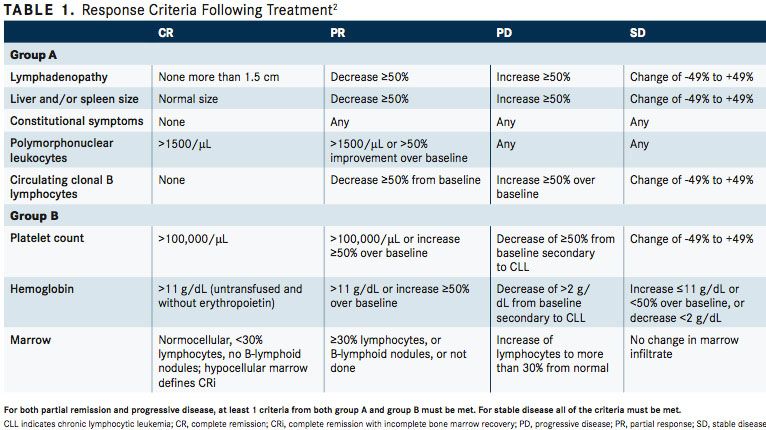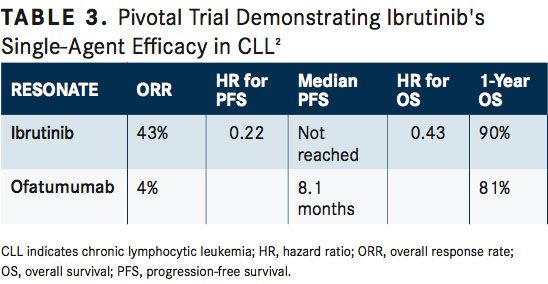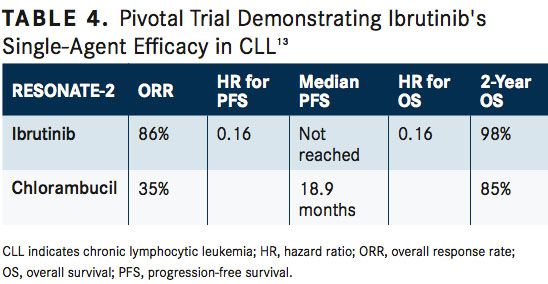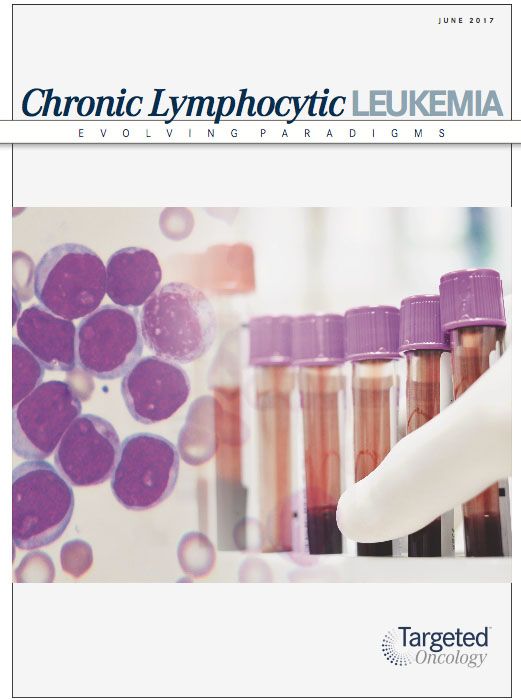Factors Affecting Prognosis and Treatment in CLL
An overview of the factors affecting prognosis and treatment in chronic lymphocytic leukemia.
1
With changing treatment paradigms, particularly the use of oral targeted agents, predictive value and use of prognostic factors to determine treatment choice are shifting. Traditional risk factors, including disease stage and lymphocyte doubling time, are becoming less relevant for treatment selection, and the predictive value of cytogenetic and molecular markers on response to treatment with novel agents is being rede ned based on the outcomes of recent trials.25
CHARACTERIZING RESPONSE IN CLL
In 2008, the International Workshop on Chronic Lymphocytic Leukemia (iwCLL) published revised guidelines for the diagnosis and treatment of CLL.6These revised guidelines acted as an update to the National Cancer Institute sponsored Working Group's (NCI-WG) 1996 guidelines,7which sought to create recommendations for the design and conduct of clinical trials for patients with CLL. The iwCLL updates these guidelines following significant progress in determining prognostic markers, diagnostic parameters, treatment options, and more for the diagnosis and response to treatment for patients with CLL.
When assessing the level of response to treatment in patients with CLL, a physical exam is required, along with evaluation of the blood and marrow. Unlike response assessment in solid tumors, imaging studies, particularly CT scans, are not usually necessary.
The characterization of a complete remission (CR) as defined by the iwCLL requires the absence of clonal lymphocytes in the peripheral blood, no hepatomegaly or splenomegaly, and the absence of constitutional symptoms, all within 3 months of the completion of therapy.6Additionally, polymorphonuclear leukocyte levels should be above 1500/μL, platelets above 100,000/μL, and hemoglobin above 11 g/dL untransfused (TABLE 12). Previously, a CR according to the NCI-WG still had detectable minimal residual disease (MRD). A partial remission (PR) depends upon at least 1 parameter relating to the tumor load and another relating to the function of the hematopoietic system or marrow improving, with 1 of these factors lasting for at least 2 months. Progressive disease (PD) is also determined by a change in the tumor load and/or a decrease in platelet or hemoglobin levels. Additionally, the guidelines define a CR in the absence of MRD as the complete eradication of the leukemia, where blood or marrow expresses less than 1 CLL cell per every 10,000 leukocytes.
DISEASE CHARACTERISTICS AFFECTING PROGNOSIS AND GUIDING TREATMENT SELECTION
The presence of a deletion of chromosome 17p (del[17p]) and mutated TP53 represent the most relevant disease characteristics that guide the choice of therapy in patients with CLL.8Del(17p) causes the loss of 1 TP53 allele and is associated with mutations in the remaining TP53 allele in more than 80% of patients, resulting in loss or dysfunction of TP53. Both del(17p) and mutated TP53 are associated with poor response to chemotherapy-based regimens, short progression-free survival (PFS), and poor overall survival (OS), independently of IGHV mutation status (TABLE 2).1,9,10Recent trials have demonstrated activity of novel targeted agents in patients with del(17p)/TP53-mutant CLL, who are considered a distinct subgroup who require a specific therapeutic approach.1,11This has significantly changed outcomes for this subgroup for whom previous options to increase the duration of response were largely limited to stem cell transplant in eligible patients.1
Ibrutinib (Imbruvica), a first-in-class oral covalent inhibitor of Bruton’s tyrosine kinase (BTK), blocks an essential component of the B-cell receptor cascade, inhibiting survival signaling between CLL cells and the tumor microenvironment. The agent was approved by the FDA in 2014 for the treatment of patients with relapsed/refractory CLL, supported by outcomes of phase II and III studies demonstrating high response rates (71%),12 higher objective response rates (ORR; 43% vs 4%), and significantly improved PFS compared with treatment with ofatumumab (Arzerra); (not reached vs 8.1 months at median follow-up of 9.4 months), and OS benefit (1-year OS, 90% vs 81%; HR for death, 0.43; P = .005) (TABLE 33). Importantly, the phase III RESONATE study showed that efficacy differences were retained in patients carrying del(17p) and in those resistant to purine analogues.2
The CLL indication of ibrutinib has recently been expanded to include frontline therapy, in part based on outcomes from the phase III RESONATE-2 study comparing ibrutinib with chlorambucil in 260 elderly treatment-naïve patients with CLL.13Ibrutinib induced a signi cantly higher ORR (86% vs 35%), longer median PFS (not reached vs 18.9 months), and a longer OS (98% vs 85% at 2 years) (TABLE 413).This study specifically excluded patients with known del(17p) CLL; however, a recently published single-arm phase II study also demonstrated activity in previously untreated patients and in those with relapsed/ refractory CLL with del(17p) or TP53-mutant disease, with an objective response rate of 97% among untreated patients and 80% among relapsed/refractory patients after a median follow-up of 2 years.14
Ibrutinib is considered the preferred first-line therapy for patients with del(17p)/TP53-mutant CLL and is a category 1 recommendation for patients with CLL without del(17p)/TP53 mutation who are frail or, are ≥65 years, or younger with significant comorbidities, according to the National Comprehensive Cancer Network (NCCN) guidelines on CLL.1
As Steven E. Coutre, MD, a hematologist with Stanford University and co-investigator of the RESONATE-2 trial, explained in an interview with the American Journal of Managed Care®, “We had patients between the ages of 65 and 70, and then we had those 70 years and older. Again, those patients 70 years and older would be an average CLL patient who’s starting therapy. And we saw benefit in both groups. There really was no distinction. It also speaks to the fact that it’s well tolerated. So, often patients who are older, of course, have more comorbiditiesdiabetes, hypertension, the usual things that we see. And that didn’t impact either the ef cacy or the tolerability of the treatment.”15
The long-term outcomes with first-line ibrutinib remain to be determined. Coutre added, “The real value is going to be to see how those patients do as they continue on ibrutinib.... In the RESONATE-2 trial, there are only 3 patients who came off ibrutinib because of progressive disease. And, although follow-up of them is still shortmeasured in months, not years—none of those patients have gone on to subsequent treatment yet.


We have a limited experience from our very first trial. I have a few patients on that trial who have been receiving ibrutinib for more than 6 years now.”16
With the availability of targeted therapies, which also include idelalisib (Zydelig) and venetoclax (Venclexta) for the treatment of patients with relapsed/refractory CLL, the question how to optimally sequence agents has become highly pertinent. Findings of a retrospective study evaluating outcomes with targeted therapies suggest better outcomes with ibrutinib as the first kinase inhibitor compared with idelalisib, superior outcomes with an alternate kinase inhibitor or venetoclax than with chemoimmunotherapy combinations after kinase inhibitor failure, and possibly better outcomes with venetoclax after ibrutinib failure.17Consequently, the authors emphasized the need for trials testing sequencing strategies to optimize treatment algorithms.
DEL(11Q) IS NOT A NEGATIVE PROGNOSTIC PREDICTOR FOR RESPONSE TO IBRUTINIB
The del(11q22.3) cytogenetic abnormality, which is detected in up to 20% of patients with CLL at diagnosis and at a higher frequency in relapsed/refractory CLL, has traditionally been considered an unfavorable cytogenetic alteration associated with extensive lymphadenopathy, disease progression, and shorter median survival (79 months).9The presence of del(11q) predicts poor response to chlorambucil-, udarabine-, or FCR ( udarabine, chlorambucil, rituximab [Rituxan])-based regimens, with shorter duration of remission and OS compared with other cytogenetic groups.9,18Previous findings have shown that adding an alkylating agent such as cyclophosphamide to udarabine-based chemoimmunotherapy can improve outcomes.1
A recent study has now investigated whether the presence or absence of del(11q) was associated with clinical outcomes following treatment with the BTK inhibitor ibrutinib in phase III studies. Lead investigator Thomas J. Kipps, MD, PhD, from the University of California Moores Cancer Center, and colleagues presented these findings at the 2016 American Society of Hematology Annual Meeting.3
The study was based on patient data from 3 phase III studies that had demonstrated superiority of single-agent ibrutinib to treatment with ofatumumab in relapsed/refractory CLL (RESONATE),3to chlorambucil in treatment-naïve CLL (RESONATE-2),13and of ibrutinib in combination with bendamustine and rituximab (BR) to treatment with BR in relapsed CLL (HELIOS).19
Analyses of pooled data of 1210 patients with available data on del(11q) revealed that the presence of del(11q) was not an adverse prognostic factor for PFS in patients who received ibrutinib-based treatment (n = 609 patients; 179 with del(11q), 430 without) but was in those who received the respective comparator treatment (n = 601; 149 with del[11q], 452 without).3The presence versus absence of del(11q) was associated with prolonged PFS (24-month, 82% vs 75%) and OS (30-month, 93% vs 86%) in ibrutinib-treated patients, but shorter PFS (9% vs 19%) in comparator-treated patients. Furthermore, treatment with ibrutinib was associated with superior clinical outcomes versus comparators regardless of del(11q) status.3
“The data gathered on ibrutinib’s role in treating chronic and small lymphocytic leukemia patients with del(11q) are encouraging for these patients. As physicians, we always want patients to understand that they have options and, for our part, it’s a matter of understanding how to adjust treatment for them,” said Kipps in a prepared statement.20


IGHV MUTATIONAL STATUS AND THE SELECTION OF FRONTLINE AND SUBSEQUENT THERAPY
Mutational status of the IGHV in the CLL clone has been increasingly considered as a parameter when determining treatment choice, whereas del(11q) is no longer considered a marker with relevance for treatment selection in current guidelines by the National Comprehensive Cancer Network (NCCN).1CLL cells expressing unmutated IGHV originate from B cells that have not undergone somatic hypermutation, which has been associated with a more aggressive disease course and poor outcomes with standard chemotherapy-based regimens.21
Long-term follow-up from the CALGB 9712 study of first-line therapy with concurrent versus sequential fludarabine and rituximab found unmutated IGHV a significant independent predictor for shorter PFS and OS, and del(17p) or del(11q) independent predictors for shorter survival.5
Recently updated results from the phase III CLL8 study found TP53 mutation, del(17p) and unmutated IGHV the strongest predictors of shorter PFS and OS.5 Study ndings further con rmed survival benefits of FCR versus FC in physically fit previously untreated CLL patients <65 years (5-year OS, 80.9% vs 69.2%; P = .002).1In patients with mutated IGHV, FCR was associated with improved survival in all cytogenetic groups except del(17p) compared with FC (median PFS not reached vs 41.9 months, P <.001; 5-year OS, 86.3% vs 79.8%).
“Of the patients with del(11q), considered an adverse prognostic group, patients with IGHV mutations responded very well to FCR and, as a consequence, showed an outcome similar to other (non-del[17p]) patients,” stated lead study author Kirsten Fischer, MD, of the University of Cologne, Germany, and colleagues in their study, which was published in Blood. “This observed benefit of FCR for the majority of IGHV-mutant patients should be considered in the design of future clinical trials. First, this finding may announce the emergence of a therapeutic approach that is guided by the IGHV mutational status.”3
Likewise, initial phase II results of a study presented at the 2017 ASCO Annual Meeting found that patients with IGHV-mutated CLL had high rates of MRD-negative status in bone marrow after receiving first-line treatment with a combination of ibrutinib, fludarabine, cyclophosphamide, and obinutuzumab (iFCG).22Results showed an ORR of 100% among patients who completed 3 cycles of iFCG, and 29 patients (83%) achieved MRD-negative status.
In contrast, IGHV mutational status does not predict response to ibrutinib, according to an integrated analysis of data from the phase III RESONATE, RESONATE-2, and HELIOS studies presented at the 2017 American Association for Cancer Research Annual Meeting.23According to Kipps et al, “IGHV-unmutated CLL was an adverse predictor of outcome for comparator-treated, but not for ibrutinib-treated patients.”23
The pooled analysis was comprised of data from 985 CLL/ SLL participants in the 3 studies, including 494 patients who received ibrutinib (351 with IGHV-unmutated disease and 143 with mutated IGHV) and 491 patients who received the respective control treatment ofatumumab, chlorambucil, and/or BR (366 with IGHV-unmutated CLL and 125 with IGHV mutations). At a median follow-up of 21.4 months for patients receiving ibrutinib and 20.6 months for those on control treatment, PFS and OS were similar among ibrutinib-treated patients (P = .93 for ibrutinib vs control), regardless of IGHV mutation status (2-year OS, 88% vs 89% for IGHV-unmutated and mutated disease, respectively; P = .86). In patients receiving control treatments, IGHV-unmutated disease was associated with shorter survival than IGHV-mutationharboring disease, also in multivariate analyses that adjusted for age, sex, baseline ECOG performance status, del(11q) and del(17p) status, prior lines of therapy, and other prognostic variables (2-year OS, 78% vs 87%; adjusted P = .01).23
PATIENT CHARACTERISTICS AND EVOLVING BASIS FOR TREATMENT DECISIONS IN CLL
Treatment decisions in CLL are generally based on the distinct molecular profile of their disease and age as well as the fitness of the patient.1,8However, current NCCN guideline recommendations for the group of patients with CLL who have del(17p)/TP53 mutations are universal and not stratified by patient age or condition.1Recommended frontline therapy options in order of preference are ibrutinib, dose-dense high-dose methylprednisolone (HDMP) plus rituximab, obinutuzumab plus chlorambucil (category 3), and the anti-CD52 an- tibody alemtuzumab (Lemtrada) alone or in combination with rituximab. Ibrutinib also leads the list of preferred regimens for relapsed/ refractory disease, followed by venetoclax with or without rituximab, idelalisib plus rituximab, single-agent idelalisib, and other rituximab and ofatumumab-based therapies. Suggested post first- and second-line maintenance therapies include lenalidomide (Revlimid) in high-risk patients, and lenalidomide or ofatumumab, respectively.1
In patients with CLL without del(17p)/TP53 mutations, the most important features directing treatment choices are advanced age of >65 years, the presence of medical comorbidities, and the objectives of treatment.8
Preferred first-line therapies for frail patients are obinutuzumab (Gazyva) plus chlorambucil, followed by ibrutinib (both category 1 recommendations), ofatumumab plus chlorambucil, rituximab plus chlorambucil, single-agent obinutuzumab, rituximab, and chlorambucil. The same treatment options are available for patients ≥65 years and younger patients with signifcant comorbidities, with the inclusion of bendamustine with rituximab following rituximab and chlorambucil in preference.1
For patients <65 years without comorbidities, chemoimmunotherapy remains the standard frontline treatment, with FCR as category 1, FR, and PCR, and bendamustine plus rituximab, as well as ibrutinib (category 2A).1
For the treatment of relapsed/refractory CLL without del(17p)/TP53 mutations, ibrutinib is the preferred regimen in patients of all performance groups, followed by idelalisib plus rituximab, venetoclax with or without rituximab, chemoimmunotherapy regimens that are again guided by patient performance, and various CD20 monoclonal antibody-based regimens. Lenalidomide or ofatumumab can be considered for postsecond-line maintenance therapy.1With accumulation of data from clinical trials, these recommendations are likely going to evolve in the near future.
“Certainly for relapsed therapy, the kinase inhibitors have moved in, led by ibrutinib,” stated Jennifer Brown, MD, PhD, of Dana-Farber Cancer Institute, in a presentation at the 2016 ASCO Annual Meeting.24“For patients with a long duration of remission to prior chemoimmunotherapy and low-risk cytogenetics, it could be reasonable to repeat chemoimmunotherapy, but that’s not going to be the most common. For the frontline treatment of fit, young patients, chemoimmunotherapy certainly remains the standard, pending ongoing trials.”23
Considering the long-term remissions reported with FCR and unknown long-term efficacy of ibrutinib and idelalisib, many open questions in respect to the best treatment choice remain. Brown added, “One of the ways to solve these problems is to find effective, well-tolerated combinations that induce remissions that are deep that might allow us to stop therapy after a relatively short fixed period of time.”23
References:
- National Comprehensive Cancer Network (NCCN). NCCN Clinical Practice Guide- lines in Oncology (NCCN Guidelines): Chronic Lymphocytic Leukemia/Small Lymphocytic Lymphoma. Version 2.2017. NCCN website. https://www.nccn.org/ professionals/physician_gls/pdf/cll.pdf. Published February 21, 2017. Accessed May 15, 2017.
- Byrd JC, Brown JR, O’Brien S, et al. Ibrutinib versus ofatumumab in previously treated chronic lymphoid leukemia. N Engl J Med. 2014;371:213-223. doi: 10.1056/NEJMoa1400376.
- Kipps TJ, Hillmen P, Demirkan F, et al. 11q Deletion (del11q) is not a prognostic factor for adverse outcomes for patients with chronic lymphocytic leukemia/small lymphocytic lymphoma (CLL/SLL) treated with ibrutinib: pooled data from 3 ran- domized phase 3 studies. Blood. 2016;128(22): 2042.
- Fischer K, Bahlo J, Fink AM, et al. Long-term remissions after FCR chemoimmu- notherapy in previously untreated patients with CLL: updated results of the CLL8 trial. Blood. 2016;127:208-215. doi: 10.1182/blood-2015-06-651125.
- Woyach JA, Ruppert AS, Heerema NA, et al. Chemoimmunotherapy with fluda- rabine and rituximab produces extended overall survival and progression-free survival in chronic lymphocytic leukemia: long-term follow-up of CALGB study 9712. J Clin Oncol. 2011; 29(10):1349-1355.
- Hallek M, Cheson BD, Catovsky D, et al. Guidelines for the diagnosis and treatment of chronic lymphocytic leukemia: a report from the International Workshop on Chronic Lymphocytic Leukemia updating the National Cancer Institute-Working Group 1996 guidelines. Blood. 2008;111(12):5446-5456. doi: 10.1182/blood-2007-06-093906.
- Cheson BD, Bennett JM, Grever M, et al. National Cancer Institute-sponsored Working Group guidelines for chronic lymphocytic leukemia: revised guide- lines for diagnosis and treatment. Blood. 1996;87(12):4990-4997.
- Kipps TJ, Stevenson FK, Wu CJ, et al. Chronic lymphocytic leukaemia. Nat Rev Dis Primers. 2017;3:16096. doi:10.1038/nrdp.2016.96.
- Döhner H, Stilgenbauer S, Benner A, et al. Genomic aberrations and survival in chronic lymphocytic leukemia. N Engl J Med. 2000;343:1910-1916. doi: 10.1056/NEJM200012283432602.
- Hallek M, Fischer K, Fingerle-Rowson G, et al. Addition of rituximab to fluda- rabine and cyclophosphamide in patients with chronic lymphocytic leukae- mia: a randomised, open-label, phase 3 trial. Lancet. 2010; 376(9747):1164- 1174. doi: 10.1016/S0140-6736(10)61381-5.
- Stilgenbauer S. Prognostic markers and standard management of chronic lymphocytic leukemia. Hematology Am Soc Hematol Educ Program. 2015;2015:368-377. doi: 10.1182/asheducation-2015.1.368.
- Byrd JC, Furman RR, Coutre SE, et al. Targeting BTK with ibrutinib in relapsed chronic lymphocytic leukemia. N Engl J Med. 2013;369:32-42. doi: 10.1056/ NEJMoa1215637.
- Burger JA, Tedeschi A, Barr PM, et al. Ibrutinib as Initial Therapy for Patients with Chronic Lymphocytic Leukemia. N Engl J Med. 2015;373:2425-2437. doi: 10.1056/NEJMoa1509388.
- Farooqui MZ, Valdez J, Martyr S, et al. Ibrutinib for previously untreated and relapsed or refractory chronic lymphocytic leukaemia with TP53 aberrations: a phase 2, single-arm trial. Lancet Oncol. 2015;16(2):169-176. doi: 10.1016/ S1470-2045(14)71182-9. Accessed May 18, 2017.
- American Journal of Managed Care® (AJMC®). RESONATE-2 trial: safety and ef- ficacy updates. Published September 2, 2016. AJMC® website. www.ajmc.com/ insights/updates-in-the-treatment-of-chronic-lymphocytic-leukemia/resonate- 2-trial-safety-and-efficacy-updates. Accessed May 18, 2017.
- American Journal of Managed Care® (AJMC®). Patient selection for treatment with ibrutinib in CLL. Published September 2, 2016. AJMC® website. www. ajmc.com/insights/updates-in-the-treatment-of-chronic-lymphocytic-leuke- mia/patient-selection-for-treatment-with-ibrutinib-in-cll. Accessed May 18, 2017.
- Mato AR, Hill BT, Lamanna N, et al. Optimal sequencing of ibrutinib, idelal- isib, and venetoclax in chronic lymphocytic leukemia: results from a multi- center study of 683 patients. Ann Oncol. 2017;28:1050-1056.
- Woyach JA, Byrd JC. Established Prognostic Markers in Chronic Lymphocytic Leukemia and Use in Clinical Practice. ASCO University Educational Book. 2011; 242-245.
- Chanan-Khan A, Cramer P, Demirkan F, et al. Ibrutinib combined with benda- mustine and rituximab compared with placebo, bendamustine, and rituximab for previously treated chronic lymphocytic leukaemia or small lymphocytic lymphoma (HELIOS): a randomised, double-blind, phase 3 study. Lancet Oncol. 2016;17(2):200-211. Accessed May 18, 2017.
- Abbvie. IMBRUVICA (ibrutinib) chronic lymphocytic leukemia/ small lymphocytic lymphoma 5-year analysis and long-term RESONATE-2 follow-up data at ASH 2016 show lasting efficacy. PR Newswire website. www. prnewswire.com/news-releases/imbruvica-ibrutinib-chronic-lymphocytic-leu- kemiasmall-lymphocytic-lymphoma-5-year-analysis-and-long-term-resonate- 2-follow-up-data-at-ash-2016-show-lasting-efficacy-300372517.html. Published December 3, 2016. Accessed May 18, 2017.
- Oscier DG, Gardiner AC, Mould SJ, et al. Multivariate analysis of prognos- tic factors in CLL: clinical stage, IGVH gene mutational status, and loss or mutation of the p53 gene are independent prognostic factors. Blood. 2002;100:1177-1184.
- Jain N, Thompson PA, Burger JA, et al. Ibrutinib, fludarabine, cyclophosphamide, and obinutuzumab (GA101) (iFCG) for previously untreated patients with chronic lymphocytic leukemia, (CLL) with mutated IGHV and non-del (17p). J Clin Oncol 2017; 35 (suppl; abstr 7522).
- Kipps TJ, Fraser G, Coutre S, et al. Unmutated IGHV is not an adverse predic- tor of outcome to therapy with ibrutinib in patients with chronic lymphocytic leukemia/small lymphocytic lymphoma (CLL/SLL). Presented at: 2017 AACR Annual Meeting, March 1-5, 2017; Washington, DC. Abstract CT158/24.
- Brown JR. Targeted therapy in chronic lymphocytic leukemia: where are we now? Presented at: 2016 ASCO Annual Meeting; June 3-7, 2016; Chicago, IL. http://meetinglibrary.asco.org/content/51067?media=vm.
